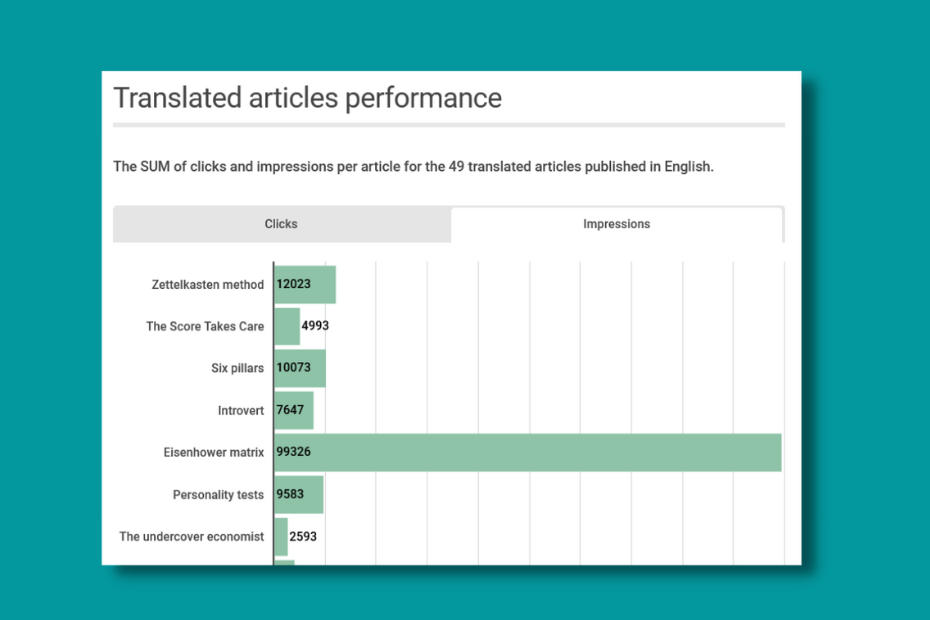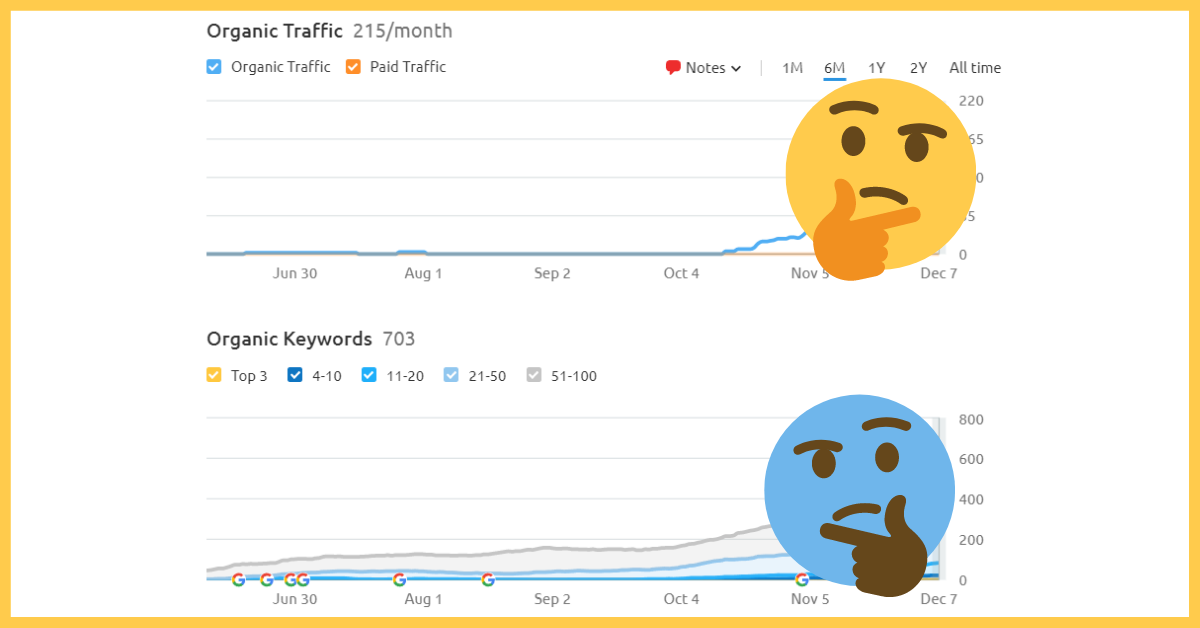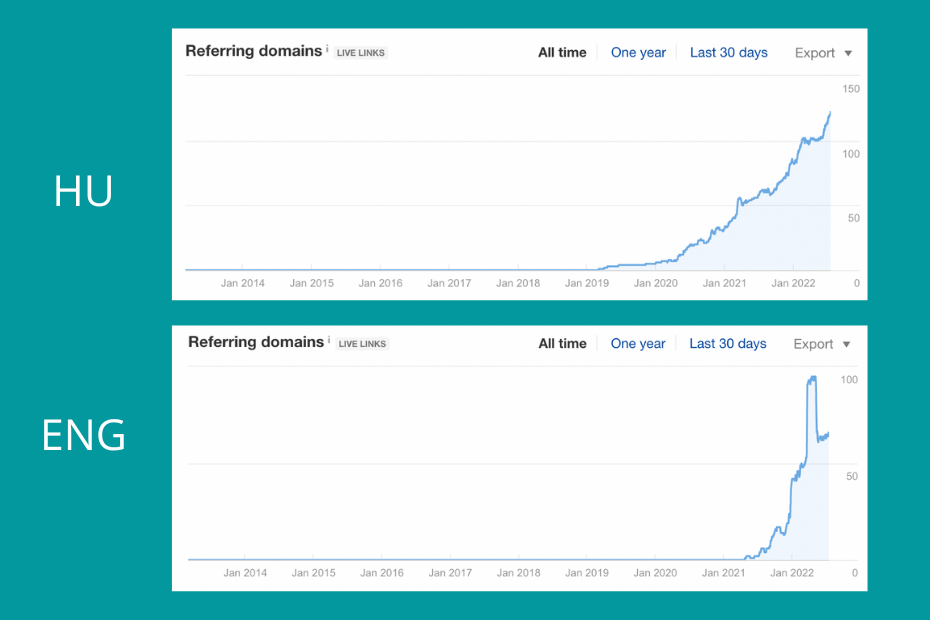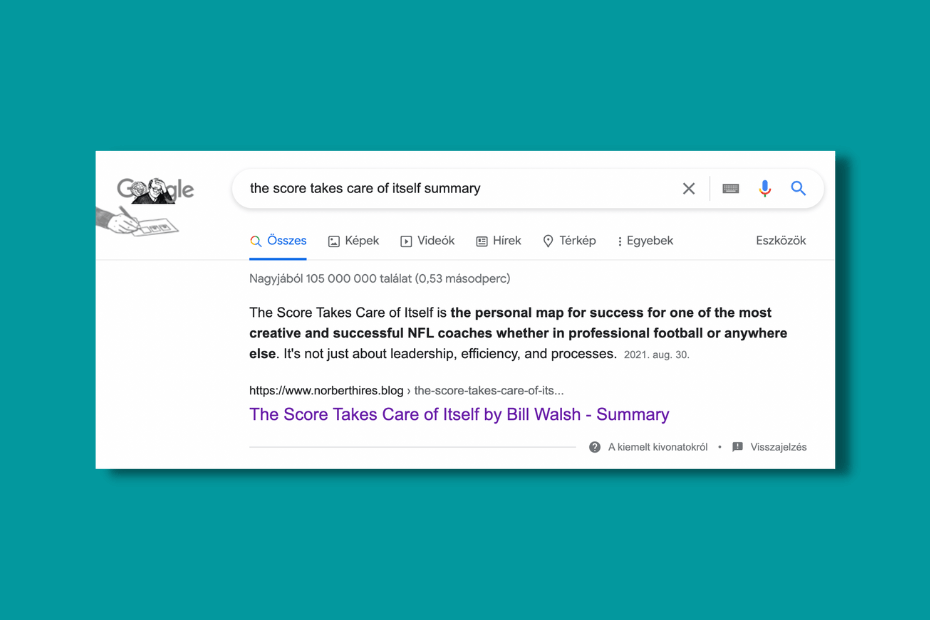Translated Content SEO: Results after 6 months
An experiment on how translated SEO content can perform in Google Search 6 months after launch.

Six months ago I launched an experiment by translating 50 articles from my Hungarian blog and publishing them with hreflang on this new domain. I wrote an article about the initial results and the setup I used to conduct the experiment.

Now I want to get a little bit deeper.
I focused on the big picture last time. I showed you how much traffic translated content could bring to a new site. But I did have other ideas to test and now I have some data to see whether those ideas can work or not.
I was interested in:
- How does translated content perform compared to its original version?
- Can book summaries bring more traffic in English than they do in Hungarian?
- How good is Ghost for SEO?
- Can I get into Google Discover with a new site?
- Do I have any chance to rank for high search volume keywords in English with content that ranked in the top 3 in another language?
So this time we go through the details with page and keyword level metrics on the performance of translated SEO content. After presenting the data I share with you why I did this experiment and how it influenced the topics and type of articles I write about.
But before we start I want to comment on a missing piece.
Off-Page SEO

The perfect sandbox for an experiment like this would be to give the same chances to the two sites. They have similar technical foundations, the content is obviously the same with localized images. But there is a big difference if we look at the off-page SEO of the two sites.
The backlink portfolio of my Hungarian blog was built up organically over the years. I wrote a few guest posts (less than five) but the site acquired the majority of links through organic mentions. Sitting at the top of Google for several keywords through the years helped because sites referenced me as a source organically.
But I did not focus at all on getting any links for the English blog.
There are a high number of referring domains pointing to the Hungarian sites which are scrapers and spammers, but the site has valuable mentions as well from credible sources.
This new blog however gets referenced only by spammers and has less than five worth to mention links.
Maybe focusing on getting a few initial links or giving more time to get exposure for the new sites could change the results, but here we are now.
Original vs. Translated Content SEO Performance
I collected clicks & impressions for both sites for the last three months. The above chart shows the summary of the two sites based on the different metrics.
I took into consideration only the 49 translated pages and excluded the remaining 50+ articles from the Hungarian sites and did not include writings published on this blog outside the scope of the experiment.
So we are comparing apples to apples.
If we look at clicks, the results are disappointing. The translated articles got only 1.191 clicks while the original pages received 142.352 clicks during the same time frame.
Looking at impressions though the results are not that bad. Translated articles get 11.59% of all impressions while previously they get only less than 1% of all clicks.
Learnings on clicks & impressions
If we go one level deeper in the next charts we will see that a few articles just didn't work out in English. The translated version of the best-performing Hungarian articles did not have a chance to get listed on Google at all.
Existing demand does not necessarily mean that we have a realistic opportunity to translate them into traffic. For high search volume keywords like "best podcasts" or "mind map" competition is much bigger in English than is smaller countries.
Book Summaries vs. SEO Content
I placed an experiment inside the experiment.
Though I mainly translated the best-performing SEO-optimized articles of my Hungarian blog (33 articles), I also added a few book summaries (16 book summaries).
I knew that in Hungary there is often no demand for the titles I was covering. Nobody heard about these books which often are not even translated to Hungarian. Since I am using SEO as my main acquisition channel that meant that I invested 10+ hours just writing the summary and at the end of the day it reached 4 people.
I am not writing to convert my time into money, so page views are not the most important KPIs in my life but I would like to have an impact with the stuff I do.
I was curious whether I can reach more people with book summaries in English.
Based on the results it turned out that clicks and even impressions for book summaries take a considerably bigger slice of the pie in English than in Hungarian. Though I published twice as much keyword-driven content, book summaries drove 45% of all clicks to the translated content.
However, the generated clicks for book summaries in English (547 clicks) did not even come close to the level that the Hungarian book summaries generated (9526 clicks).
Learnings on different formats
- In short term (without topical authority) it makes sense to publish more book summaries than keyword-driven content. Especially if there is high competition in the given niche.
- Books can be a tough niche to rank in as well. I could drive traffic with less popular titles but for the titles performing best in Hungarian, I did not have a chance to rank in English.
Page level overview
We can draw the main conclusions from top-level metrics but there are most of the time outliers we would miss without going one step deeper.
and
In Hungarian, there are 4-5 top articles heavily contributing to the overall clicks, but the long-tail here is real. Almost every article brings a few hundred clicks.
The translated versions do not come close to this performance. They can sometimes can have bigger visibility and show up in search, but they rarely rank well enough to get meaningful clicks.
There are only five articles which got more clicks in English than in Hungarian:
- The Zettelkasten Method - ENG: 153 clicks, HUN: 114 clicks
- The Score Takes Care of Itself - ENG: 131 clicks, HUN: 4 clicks
- The Undercover Economist - ENG: 58 clicks, HUN: 4clicks
- The ROI of Reading - ENG: 19 clicks, HUN: 6 clicks
- Range by David Epstein - ENG: 15 clicks, HUN: 8 clicks
Learnings on page level performance
- My hypothesis that book summaries published in English can drive more clicks turned partially true.
- If there is worldwide demand for a popular book then publishing its summary in Hungarian still makes sense. (There is demand and I have the chance to rank)
- I can not rank for the most popular titles at this point.
- For less well-known books and niche subjects, English can help to amplify reach.
And also I can drive extra traffic with featured snippets in English which is not the case in Hungarian (we do not have them).

Image Traffic
Especially for the keyword-driven content, I make some custom illustrations in both languages. In English results, it is better rewarded than in Hungarian. Maybe there are more Image Packs in Search or there are more visual searches in English.
Google Discover
I managed to get into Google Discover since the start of the new site, though it does not bring reasonable traffic.
But the 86 clicks and 1215 impressions for the last 3 months are a good sign anyway, since the unpredictable nature of Google Discover. Often it is harder to get in than get more traffic.
What did I learn during this experiment?
I used this experiment not just to test whether translated content can perform well in search or not, but to influence my future topic and language choices.
- It turned out that sometimes it makes more sense to publish articles without detectable demand than to write content in a competitive niche without the real possibility to rank.
- The experiment also reinforced my assumptions that Google Search is getting more and more visual. I bet that the uplift I saw in English will translate to other languages in the future.
- There are opportunities worth considering when writing in English. With the excerpts of Ghost for some articles, I became eligible for a featured snippet. This is something I did not consider before. For future articles, it makes sense to write a concise summary to get even more impact.
- Topical authority matters more in English than in Hungarian. For my Hungarian sites, the best-performing articles are touching diverse, unrelated topics (fitness, self-help, marketing). In English, I did not have the chance to rank for most of these queries even if the competition was not that advanced.
This is the last piece I publish about this experiment. If you did not read the first chapter then head to How I Translated 50 SEO Articles (and what happened next), if you are sick of SEO then check Why you shouldn't write an SEO-driven blog.




